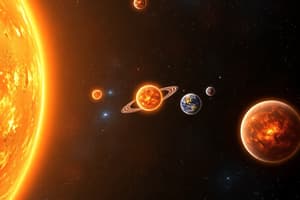Podcast
Questions and Answers
What happens to a star when its core begins to run out of fuel?
What happens to a star when its core begins to run out of fuel?
- It transforms into a black hole immediately.
- It starts to sparkle brightly and increase in temperature.
- It stops glowing and remains stable.
- It starts to die and the core collapses under its own gravity. (correct)
What is the stage known as when the outer layers of a star expand and cool?
What is the stage known as when the outer layers of a star expand and cool?
- Red Giant (correct)
- Blue Giant
- Yellow Subgiant
- Black Dwarf
What causes a star to become more compact after nuclear fusion stops?
What causes a star to become more compact after nuclear fusion stops?
- Absence of light
- Expansion of the outer layers
- Decrease in temperature
- Increase in gravity (correct)
What process releases a lot of energy and makes a star bigger and more stable before it explodes as a supernova?
What process releases a lot of energy and makes a star bigger and more stable before it explodes as a supernova?
How does the life cycle of a star typically end according to the text?
How does the life cycle of a star typically end according to the text?
What role can the remnants of a supernova play in the future according to the text?
What role can the remnants of a supernova play in the future according to the text?
What is the initial stage in the life cycle of a star?
What is the initial stage in the life cycle of a star?
What causes a protostar to generate heat during its formation?
What causes a protostar to generate heat during its formation?
Which process occurs when the temperature in a star reaches the necessary level?
Which process occurs when the temperature in a star reaches the necessary level?
What defines the stage known as the main sequence in a star's life cycle?
What defines the stage known as the main sequence in a star's life cycle?
During which stage does a star remain stable for billions of years?
During which stage does a star remain stable for billions of years?
What is the consequence of nuclear fusion in a star?
What is the consequence of nuclear fusion in a star?
Flashcards are hidden until you start studying
Study Notes
The Life Cycle of a Star: Exploring the Stages of a Celestial Phenomenon
Stars are fascinating celestial bodies that have captured the imagination of humans for centuries. They have been considered as divine entities, sources of light and warmth, and even objects of worship. However, modern science has unveiled the true nature of stars, revealing them to be massive, glowing spheres that follow a well-defined life cycle. In this article, we will delve into the intricacies of stellar evolution and explore the various stages of a star's existence.
Birth of a Star: Nebula to Protostar
A star's life begins in a nebula, a vast cloud of gas and dust. Over time, gravity pulls the hydrogen gas in the nebula together, and it begins to spin. This spinning motion causes the matter to generate heat, forming a dull red protostar. The protostar, still in the process of formation, is not yet a stable star. It continues to heat up due to the gravitational pressure, eventually reaching the temperature required for nuclear fusion to occur.
The Main Sequence: Nuclear Fusion and Stability
Once the temperature reaches the necessary level, nuclear fusion takes place. Nuclei combine to create a larger mass, and the cloud glows with brightness, becoming smaller and more stable. This stage, known as the main sequence, can last for billions of years. During this time, the star remains stable, with the energy produced by nuclear fusion balancing the inward pull of gravity.
Death as a Red Giant: Core Fusion and Expansion
As a star ages, its core begins to run out of fuel. When this happens, the star starts to die. The core collapses under its own gravity, causing the outer layers of the star to expand and cool. This stage is known as a red giant, and it can undergo several cycles of core fusion and expansion.
Supernova: Explosion and Remnants
Eventually, the star reaches the end of its life. Once the nuclear fusion stops, gravity presses on the star, making it more compact. From this action, temperatures rise to where helium can fuse with carbon. Once the temperature reaches levels that allow fusion (light and heavy) to happen again, core fusion begins. This process releases a lot of energy, and the star becomes bigger and more stable. However, this stability is short-lived, and the star explodes as a supernova. The remnants of the star can trigger the future formation of stars, bring heat to interstellar gas, and become the main source for heavy elements.
In conclusion, the life cycle of a star is a fascinating journey from its birth in a nebula to its death as a supernova. Each stage is marked by unique characteristics and processes that shape the star's evolution. Understanding these stages allows us to appreciate the complexity and beauty of these celestial bodies that light up our night sky.
Studying That Suits You
Use AI to generate personalized quizzes and flashcards to suit your learning preferences.




